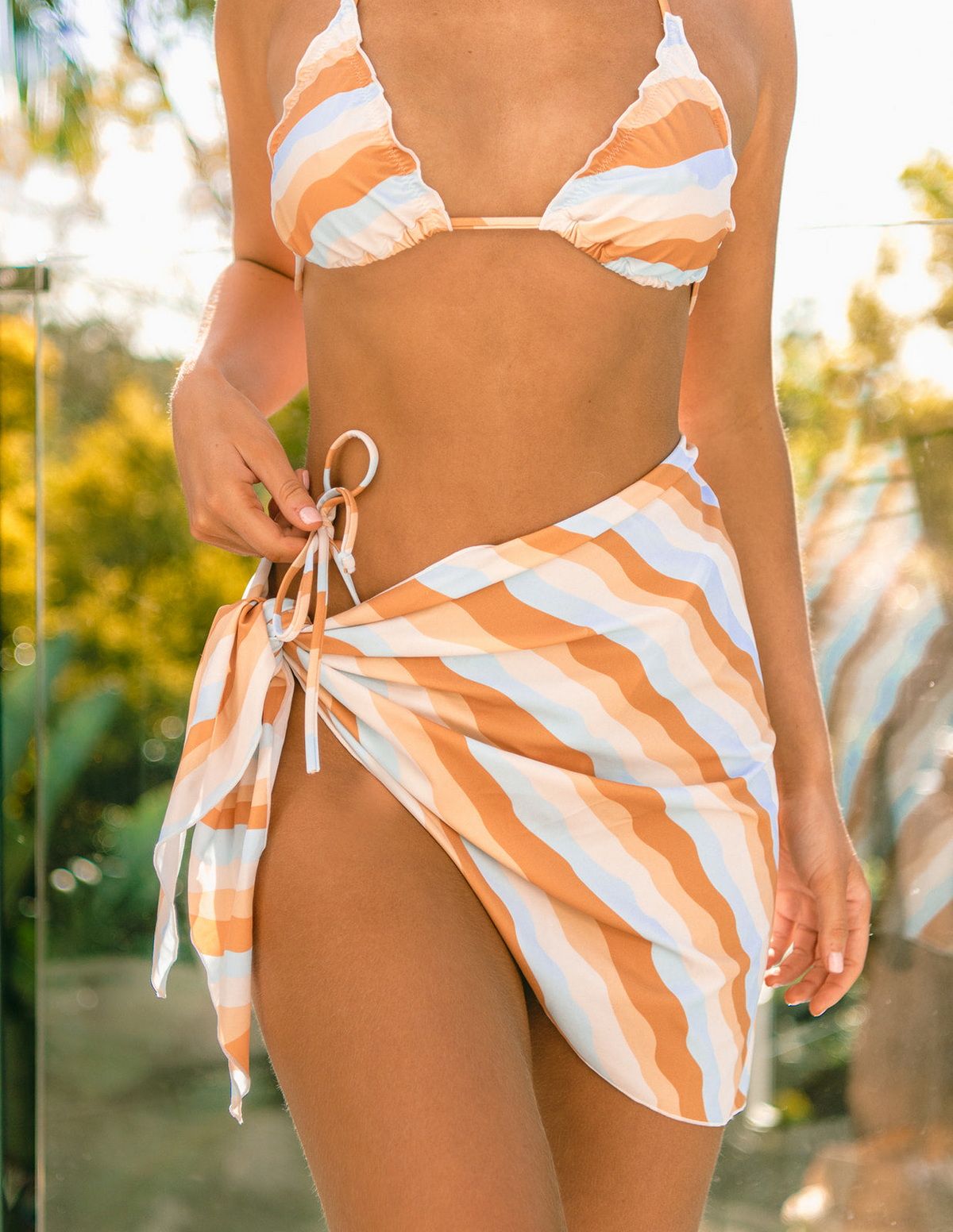Content Menu
● Introduction
● History and Origin
● Cultural Significance
● Modern Usage
>> Popular Styles of Sarongs
● How to Wear a Sarong
● Benefits of Sarong Swimwear
● Choosing the Right Sarong
● Caring for Your Sarong
● Styling Tips
● Related Questions and Answers
>> 1. What materials are sarongs made of?
>> 2. Can men wear sarongs?
>> 3. How do you care for a sarong?
>> 4. Are sarongs suitable for formal occasions?
>> 5. Where can I buy sarong swimwear?
● Conclusion
● Citations:
Introduction
A sarong is a versatile piece of clothing that has become synonymous with beachwear, particularly as a stylish cover-up for swimwear. Originating from Southeast Asia, this large piece of fabric can be wrapped around the body in numerous ways, making it a popular choice for those seeking both comfort and fashion at the beach or poolside.

History and Origin
The sarong has its roots in Southeast Asia, particularly in countries like Indonesia, Malaysia, and the Philippines. The term "sarong" is derived from the Malay word *sarung*, meaning "to cover" or "to sheath." This garment dates back over a thousand years and has been traditionally worn by both men and women across various cultures.
Historically, sarongs were made from natural fibers such as cotton or silk, which allowed them to be lightweight and breathable—ideal for tropical climates. The intricate patterns often seen on sarongs are a result of traditional dyeing techniques like *batik*, which originated in Indonesia. This method involves applying wax to fabric before dyeing it, creating beautiful designs that reflect local culture and artistry.
Cultural Significance
The sarong is more than just a fashion statement; it carries cultural significance in many regions. In Malaysia, for instance, checkered pattern sarongs are worn by Muslims during Friday prayers at the mosque. In contrast, women often wear sarongs daily for chores or errands. This differs from North America, where sarongs are primarily seen as beachwear or fashion statements.
In many parts of Asia, the sarong has been a symbol of identity and resistance against colonialism. During the colonial period, local garments like the sarong were often looked down upon by colonial powers. However, as nations gained independence, traditional clothing became a way to assert cultural identity and pride.

Modern Usage
In contemporary fashion, particularly in Western cultures, sarongs are frequently worn as chic accessories over swimsuits. They are available in various colors, patterns, and materials, making them an essential item for beachgoers. Sarongs can be styled in different ways to enhance their appeal as both functional and fashionable swimwear.
Popular Styles of Sarongs
- Classic Wrap: The most common way to wear a sarong is by wrapping it around the waist.
- Dress Style: A sarong can be tied around the upper body to create a simple dress.
- Top Option: Folding the sarong and tying it around the chest can create a stylish top.
- Beach Blanket: A sarong can also serve as a lightweight blanket for lounging on the sand.
How to Wear a Sarong
The versatility of the sarong allows for multiple styling options:
1. As a Skirt: Wrap the sarong around your waist and tie it at the side for an effortless look.
2. As a Dress: Hold the sarong horizontally behind your back, wrap it around your body, and tie it behind your neck.
3. As a Top: Fold it in half and tie it around your chest for a trendy beach top.
4. As a Scarf: Use it as a lightweight scarf or head covering for added sun protection.
5. As a Beach Blanket: Spread it out on the sand for a quick beach blanket.
Video: 13 SEXY WAYS TO TIE A SARONG WRAP | STYLING A SARONG
Benefits of Sarong Swimwear
- Versatility: Can be worn in multiple styles depending on personal preference.
- Comfort: Made from lightweight materials that are breathable and comfortable against the skin.
- Fashionable: Available in various designs that can complement any swimsuit or beach outfit.
- Easy to Pack: Sarongs are lightweight and take up minimal space in luggage, making them ideal for travel.
Choosing the Right Sarong
When selecting a sarong for swimwear, consider the following factors:
- Material: Look for breathable fabrics like cotton or rayon that dry quickly.
- Size: Ensure the sarong is large enough to wrap comfortably around your body.
- Design: Choose colors and patterns that reflect your personal style and coordinate with your swimwear.
Caring for Your Sarong
To maintain the quality of your sarong:
- Washing: Most sarongs can be hand-washed in cold water with mild detergent.
- Drying: Air-dry your sarong to prevent shrinking or damage from high heat.
- Storage: Store it flat or rolled to avoid creases.
Styling Tips
The beauty of a sarong lies in its versatility; here are some additional styling tips:
- Layering: Pair your sarong with other beach essentials like hats and sunglasses for an effortlessly chic look.
- Accessorizing: Use bold jewelry or colorful flip-flops to elevate your outfit further.
- Mixing Patterns: Don't shy away from mixing prints; try pairing floral sarongs with striped swimsuits for an eye-catching ensemble.
- Seasonal Adaptation: In cooler months, use your sarong as an outer layer over long-sleeved tops or dresses.

Related Questions and Answers
1. What materials are sarongs made of?
- Sarongs are typically made from cotton, silk, or synthetic fibers.
2. Can men wear sarongs?
- Yes, sarongs are traditionally worn by both men and women across various cultures.
3. How do you care for a sarong?
- Most sarongs can be hand-washed and air-dried; avoid using bleach or harsh chemicals.
4. Are sarongs suitable for formal occasions?
- While typically casual, some sarongs can be styled elegantly for semi-formal events.
5. Where can I buy sarong swimwear?
- Sarongs are available at most swimwear retailers, online stores, and specialty boutiques.
Conclusion
Sarong swimwear is not just practical; it's also an elegant addition to any beach wardrobe. With its rich history rooted in Southeast Asian culture and its modern adaptability to various fashion trends, the sarong remains a beloved choice among beachgoers worldwide. Whether you're lounging by the pool or taking a stroll along the shore, incorporating a sarong into your swimwear ensemble adds flair while providing comfort and versatility.
Citations:
[1] https://islandstyleclothing.net/history-of-sarongs/
[2] https://kontinentalist.com/stories/the-sarong-and-gender-colonialism-in-asia
[3] https://www.bresciabercane.com/blogs/journal/how-to-wear-our-sarongs-wrap-it-up
[4] https://www.youtube.com/watch?v=sz8R7RzxCKY
[5] https://www.harpersbazaar.com/fashion/trends/g44131550/best-sarongs-wraps/
[6] https://shawlovers.com/sarong/
[7] https://www.allsarongs.com/sarong-history-a/144.htm
[8] https://loveshushi.com/blogs/clothes-for-the-traveling-woman/sarongs-7-ways-to-wear-a-sarong
[9] https://www.lulus.com/blog/fashion/how-to-tie-a-sarong/
[10] https://en.wikipedia.org/wiki/Sarong




































